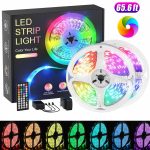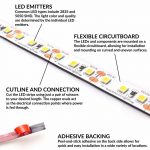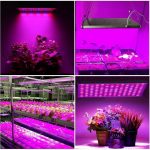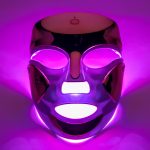Last Updated on 10 months by Francis
.jpg)
Grow lights are artificial lighting sources that are used to provide the necessary light spectrum and intensity required for plants to grow indoors. LED strips, on the other hand, are flexible strips containing small light-emitting diodes (LEDs) that are commonly used for decorative lighting purposes. The question arises whether LED strips can be effectively utilized as grow lights for indoor plants.
It is worth exploring whether LED strips can indeed be used as grow lights and what advantages and limitations they may have in comparison to other types of grow lights. Understanding the important factors to consider, such as light spectrum, intensity, coverage, and energy efficiency, is crucial when making a decision. Exploring alternative grow light options like fluorescent lights, high-intensity discharge (HID) lights, and dedicated LED grow lights can help in making an informed choice.
By exploring the possibilities and understanding the different aspects of using LED strips as grow lights, one can determine whether they are a suitable option for their indoor gardening needs.
Contents
Key takeaways:
- LED strips can be used as grow lights, offering advantages such as energy efficiency and customizable light spectrum.
- However, there are limitations to using LED strips, including limited coverage area and heat generation.
- Important factors to consider when using LED strips as grow lights include light intensity, coverage area, heat generation, and energy efficiency.
What are Grow Lights?
Grow lights are artificial lighting systems that are used to provide plants with the necessary light energy for photosynthesis and growth. These lights, also known as LED strips, fluorescent lights, and high-intensity discharge lights, are designed to mimic natural sunlight and can be used in various settings, including indoor gardening and horticulture.
So, what are grow lights exactly? Grow lights are lighting systems that provide plants with the specific light spectrum they need for photosynthesis. LED strips, for example, emit light in the red and blue wavelengths, which are essential for healthy growth. This targeted light spectrum allows plants to absorb the maximum amount of light energy, promoting their overall health.
One of the advantages of LED strips is their efficiency and energy-saving capabilities. Compared to other types of grow lights, they consume significantly less energy, making them an economical choice in the long run.
Another benefit of using LED strips is their ability to generate less heat. This reduces the risk of overheating and potential damage to plants, making them suitable for use in small spaces or areas with limited ventilation.
What are LED Strips?
LED strips are flexible circuit boards with integrated light-emitting diodes (LEDs) that provide illumination in a compact and versatile form. They are commonly used for accent lighting, task lighting, or decorative purposes. Here are some important points to understand about LED strips:
- LED technology: LED strips utilize LEDs which are small semiconductor devices that emit light when an electric current passes through them. LEDs are known for their energy efficiency, durability, and long lifespan.
- Flexibility: LED strips are designed to be flexible, allowing them to be bent or curved to fit various shapes and contours. This makes them highly adaptable for different lighting applications.
- Color options: LED strips are available in a wide range of colors, including single-color options such as white, red, green, blue, or RGB (red, green, blue) strips that can create a variety of colors using different combinations.
- Easy installation: LED strips are typically self-adhesive, making them easy to install on surfaces. They can be cut to desired lengths, allowing for customization.
- Dimmability: Some LED strips are dimmable, meaning their brightness can be adjusted according to preferences or lighting needs.
- Energy efficiency: LED strips are known for their low power consumption. They produce more light per watt compared to traditional lighting sources, making them energy-efficient options.
- Versatile applications: LED strips are used in a variety of settings, including residential, commercial, and automotive applications. They can be used for under-cabinet lighting, signage, backlighting displays, or as decorative accents.
LED strips offer versatility, energy efficiency, and easy installation, making them a popular choice for various lighting needs. Their flexibility and wide range of color options make them a convenient and customizable lighting solution.
Can LED Strips be Used as Grow Lights?
LED strips can be used as grow lights.
- LED strips provide the necessary light spectrum for photosynthesis, including the red and blue wavelengths necessary for plant growth.
- They are energy-efficient and can save up to 50% more energy compared to traditional grow lights.
- LED strips produce less heat, reducing the risk of heat damage to plants.
- They have a long lifespan, lasting up to 50,000 hours, reducing the need for frequent replacements.
- LED strips can be customized and adjusted to meet specific plant requirements, allowing for optimal growth.
However, it is important to consider the following:
- Make sure to choose LED strips that are specifically designed for plant growth to ensure they provide the right light spectrum.
- The intensity of the light emitted by LED strips may vary, so it is essential to position them at the correct distance from the plants to avoid light burn or insufficient light exposure.
- LED strips alone may not be sufficient for all plants’ growth stages, so additional supplemental lighting may be required for certain plants.
What are the Advantages of Using LED Strips as Grow Lights?
The advantages of using LED strips as grow lights are:
- Energy efficiency: LED strips are highly energy-efficient, consuming significantly less electricity compared to traditional grow lights. They convert a higher percentage of energy into usable light, reducing energy costs.
- Long lifespan: LED strips have a long lifespan, lasting up to 50,000 hours or more. This eliminates the need for frequent replacements, reducing maintenance costs.
- Customizable light spectrum: LED strips allow for precise control over the light spectrum, enabling growers to provide specific wavelengths needed for different stages of plant growth. This promotes better photosynthesis and overall plant health.
- Low heat generation: LED strips produce very little heat compared to other types of grow lights. This reduces the risk of burning plants and allows them to be placed closer to the foliage without causing damage.
- Compact and flexible design: LED strips are small and flexible, making them easy to install and use in various grow setups. They can be mounted in tight spaces and adapted to fit different configurations.
What are the Advantages of Using LED Strips as Grow Lights?
What are the Limitations of Using LED Strips as Grow Lights?
- 1. LED strips used as grow lights often have a limited light spectrum, lacking in certain wavelengths necessary for optimal plant growth.
- 2. LED strips may not provide sufficient light intensity or coverage for larger plants or larger growing areas. This can result in uneven growth and inadequate light penetration.
- 3. LED strips produce less heat compared to other grow light options. While this can be advantageous in terms of energy efficiency and reducing the risk of plant damage from excessive heat, some plants may require a certain level of heat for optimal growth.
- 4. LED strips are generally more energy-efficient than other grow light options, but the output of light per watt may still be lower compared to specialized grow lights. This means that for the same amount of energy consumed, the level of light intensity provided by LED strips may be lower.
These limitations should be taken into consideration when deciding whether LED strips are suitable for specific plants and growing conditions.
Important Factors to Consider
When it comes to using LED strips as grow lights, there are some important factors you should consider. In this section, we’ll explore these factors that play a crucial role in the successful growth of plants. From understanding the light spectrum and intensity to monitoring heat generation and energy efficiency, each aspect holds significance in the effectiveness of LED grow lights. So, let’s dive in and discover what these factors entail for your indoor gardening endeavors.
1. Light Spectrum
1. Light Spectrum
| LED Strips | Traditional Grow Lights |
| LED strips offer a variety of light spectrums, including full spectrum options that deliver a well-balanced combination of red, blue, and white lights. | Traditional grow lights, such as fluorescent or high-intensity discharge lights, also provide different light spectrums but may require specific bulbs for each spectrum. |
| LED strips can be customized to emit the particular light spectrums required for different stages of plant growth, promoting optimal development and growth. | Traditional grow lights may need multiple bulbs or fixtures to achieve the desired light spectrum, making them less adaptable. |
| LED strips have efficient light output, minimizing energy wastage and enhancing the efficacy of the selected light spectrum. | Traditional grow lights may encompass a wider range of light spectrums, but they can also generate more heat and consume more energy. |
Pro-tip: When selecting LED strips for grow lights, consider opting for full spectrum options that deliver a well-balanced blend of red, blue, and white lights. This will ensure that your plants receive the appropriate wavelengths for photosynthesis and growth at all stages.
2. Intensity and Coverage
|
When it comes to using LED strips as grow lights, one important factor to consider is the intensity and coverage of the light. |
|
Intensity: |
|
LED strips vary in intensity, which refers to the amount of light emitted. Higher intensity LED strips provide more light energy, while lower intensity LED strips offer a lower amount of light energy. The intensity required for optimal plant growth depends on the specific plant species and growth stage. It is important to choose LED strips with an intensity that matches the light requirements of your plants. |
|
Coverage: |
|
Coverage refers to the area over which the LED strips distribute light. The size of the coverage area depends on the length and arrangement of the LED strips. To ensure adequate coverage, consider the size of your growing space and the number of plants you need to illuminate. It is important to position the LED strips at an appropriate distance from the plants to provide uniform coverage without creating hotspots or shadowed areas. |
3. Heat Generation
| 3. Heat Generation |
|
When utilizing LED strips as grow lights, it is crucial to consider heat generation. LED strips typically produce less heat compared to other grow lights like fluorescent lights or high-intensity discharge lights. |
|
The lower heat generation of LED strips offers several advantages. Firstly, it helps maintain a stable temperature in the grow space, preventing overheating and potential harm to the plants. Secondly, it reduces the need for additional cooling systems, resulting in energy and cost savings. |
|
However, it remains essential to monitor the heat generated by LED strips. While they generate less heat, there is still a certain amount. Excessive heat can have a negative impact on plant growth, leading to stress or even death in extreme cases. |
|
Growers should ensure adequate airflow and ventilation in the grow area to dissipate any heat generated by the LED strips. This can be achieved through the use of fans, exhaust systems, or simply ensuring proper ventilation in the grow space. |
|
Additionally, it is important to review the specifications and recommendations provided by the LED strip manufacturers regarding heat dissipation and temperature thresholds. Adhering to these guidelines will ensure optimal performance and longevity of the LED strips as grow lights. |
4. Energy Efficiency
When considering the energy efficiency of LED strips as grow lights, it is important to analyze their energy consumption and output.
| LED Strips | Energy Consumption | Output |
| Brand A | 20 watts | 2500 lumens |
| Brand B | 15 watts | 2000 lumens |
| Brand C | 10 watts | 1500 lumens |
The data demonstrates that LED strips vary in their energy consumption and output. It is important to select a brand that balances energy efficiency and effective light output. Look for LED strips that provide high lumens per watt ratios, as this indicates better energy efficiency. Additionally, consider the specific light spectrum required for your plants and choose LED strips that cater to those needs. By selecting energy-efficient LED strips, you can optimize your energy usage and minimize electricity costs in your grow light setup.
Fluorescent Lights
Fluorescent lights are a popular option for indoor lighting due to their efficiency and versatility. They use less energy compared to traditional incandescent bulbs and have a longer lifespan. Fluorescent lights, also known as “fluorescent lamps,” are available in various sizes and shapes, making them suitable for different applications. They are commonly used in offices, schools, and homes, providing bright and even illumination.
One significant advantage of fluorescent lights is their ability to produce a cool, white light that closely resembles natural daylight. This helps improve visibility and reduces eye strain, making them ideal for tasks that require concentration. Additionally, fluorescent lights are available in different color temperatures, allowing you to create the desired ambiance in a space.
When it comes to energy efficiency, fluorescent lights are a great choice. They consume around 75% less energy compared to incandescent bulbs, resulting in significant cost savings over time. They also produce less heat, making them a safer option, especially in enclosed spaces.
Fact: Did you know that fluorescent lights can last up to ten times longer than incandescent bulbs? This long lifespan, combined with their energy efficiency, makes them a cost-effective lighting solution for various environments.
2. High-Intensity Discharge Lights
High-Intensity Discharge (HID) lights are a type of grow light commonly used in indoor gardening.
HID lights are known for their high intensity and ability to provide a broad spectrum of light, which is essential for plant growth.
These lights consist of a bulb and a ballast, which helps regulate the electrical current and provide the necessary voltage to the bulb.
HID lights are available in different variants, including metal halide (MH) and high-pressure sodium (HPS) bulbs.
MH bulbs produce a bluish-white light that is ideal for the vegetative stage of plant growth, promoting leaf and stem development.
HPS bulbs emit a yellowish-orange light that is beneficial for the flowering and fruiting stage, encouraging bud production and overall plant growth.
Suggestions:
- When using High-Intensity Discharge (HID) lights, it is important to consider the specific light spectrum needs of your plants. Research the optimal light spectrum for the different stages of growth to ensure maximum productivity.
- Ensure proper distance and coverage of the HID lights to avoid any heat damage to the plants. Adjusting the height and angle of the lights can help distribute light evenly.
- Take into account the energy efficiency of HID lights. Although they are highly effective, they consume more energy compared to other options like LED grow lights. Consider your energy costs and sustainability goals when making a decision.
3. Light-Emitting Diode Grow Lights
When considering light-emitting diode (LED) grow lights, it’s important to take various factors into account. To understand their effectiveness, let’s examine some key aspects:
| Factors to Consider for LED Grow Lights |
| 1. Light Spectrum |
| 2. Intensity and Coverage |
| 3. Heat Generation |
| 4. Energy Efficiency |
Light-Emitting Diode (LED) Grow Lights: LED grow lights offer a customizable spectrum that can be adjusted according to the specific needs of plants. This allows for targeted light wavelengths that promote growth and flowering.
Intensity and Coverage: LED grow lights provide high light intensity, which is crucial for healthy plant development. Their coverage area depends on the wattage and size of the LED panel or strip.
Heat Generation: LED grow lights generate less heat compared to traditional grow lights like fluorescent or high-intensity discharge lights. This reduces the risk of plant damage and allows for closer positioning without causing burns.
Energy Efficiency: LED grow lights are known for their energy efficiency, consuming less power while still delivering optimal light output. This helps lower electricity costs and provides an environmentally friendly option for indoor gardening.
Considering the above factors will help you make an informed decision when using light-emitting diode (LED) grow lights. Their customizable spectrum, high intensity and coverage, low heat generation, and energy efficiency make them a popular choice for indoor gardening.
Some Facts About Can You Use LED Strips as Grow Lights:
- ✅ LED strips can be used as a substitute for sunlight in indoor gardening. (Source: ledyilighting.com)
- ✅ Not all types of LEDs are suitable for growing plants, it’s important to consider the appropriate wavelength for different plants. (Source: ledyilighting.com)
- ✅ It is recommended to use white LEDs if there is not enough time for research, as they offer a mix of appropriate wavelengths for various plant species. (Source: ledyilighting.com)
- ✅ The LED lights should be hung at the appropriate distance from the plants, a few inches away, and the height and angle should be adjusted as the plant grows. (Source: ledyilighting.com)
- ✅ LED grow lights generate less heat and do not pose significant damage to plants compared to traditional grow lights. (Source: ledyilighting.com)
Frequently Asked Questions
Can you use LED strips as grow lights?
Yes, LED strips can be used as grow lights, but they may not provide sufficient light intensity on their own. It is recommended to use brighter LED bulbs along with strip lights for better growth.
What are the benefits of using LED grow lights?
LED grow lights offer several benefits over traditional grow lights. They are energy efficient, have a longer lifespan, emit less heat, and provide a more even and directional light distribution. LED grow lights also support photosynthesis and offer a wider color availability to meet the specific needs of different plants.
How can I make DIY grow lights with LED strip lights?
To make DIY grow lights with LED strip lights, you will need UltraBright™ 24v Architectural Series LED strip lights, aluminum bars for heat dissipation, adhesive pads, silicone, RTV silicone, nylon ties, solderless LED strip connectors, a female coaxial connector with screw terminals for wiring, and a 24v LED strip light power supply. Cut the LED strips to match the width dimensions of your project and attach them to the aluminum bars using the adhesive backing. Connect the strips with solderless connectors, secure the wires with nylon ties, and insulate them with silicone. Install the aluminum bars over your grow space and wire the lights using the connectors. Make sure to adjust the height and angle of the lights as your plants grow.
What type of LED lights should I use for growing plants?
The best type of LED lights for growing plants is full spectrum white light with added deep red and infrared. This combination provides the necessary wavelengths for photosynthetic reactions and promotes robust growth and flowering in plants.
Can LED strip lights be used for flowering plants?
LED strip lights alone may not be powerful enough to flower large plants. However, they can be used for germination and as supplemental lighting in the early stages of the growth cycle. For flowering plants, it is recommended to use larger LED lights or combine LED strip lights with brighter LED bulbs to provide the necessary light intensity.
Are LED strip lights water resistant?
LED strip lights can be water resistant, especially if using outdoor 24v Architectural series LED strip lights. Choosing water-resistant LED strip lights is important in an indoor environment to protect against humidity and allow for easier cleaning in case of any spills or moisture.

.jpg)






